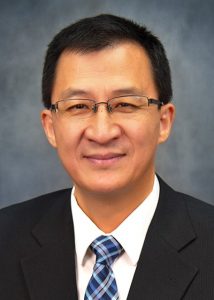ECE Faculty Member, Students Win ASEE Best Paper Award
November 18, 2024
Electrical and Computer Engineering Associate Professor Chaomin Luo and ECE graduate students Tingjun Lei and Timothy Sellers recently won ASEE Best Paper Award presented at the 2024 ASEE Annual Conference.
The award-winning paper “Enhancing Student Learning in Robot Path Planning Optimization through Graph-based Methods” was published by the American Society for Engineering Education as part of the conference proceedings. The work investigates the integration of graph-based models, such as visibility graphs, Maklink diagram, Delaunay triangulation and Voronoi diagrams, into a computational intelligence curriculum to improve students’ understanding of robot navigation and motion planning optimization.

Dr. Chaomin Luo
In particular, the research focused on students effectively applying graph-based models in real-world scenarios, emphasizing the challenges of navigating complex, obstacle-populated environments, as well as effectively integrating theory taught in the classroom with practical applications. The models, which provide structured approaches for analyzing environments and guiding robots through efficient optimization of trajectories, were a core part of a milestone project-based learning framework as part of a course.
Luo said, “This hybrid pedagogical approach provides great opportunities for students to build their robot navigation, motion planning and mapping techniques in a cohesive and iterative manner by utilizing graph-based optimization algorithms.”
A key aspect was a hybrid pedagogy using an innovative Sparrow-Dissection and Scaffolding approach associated with Active Learning (SDS-AL), focusing on hands-on learning through step-by-step guidance. It fostered deeper understanding by encouraging students to analyze the algorithm’s data structures, grid representations and distinct method of converting sensor data into real-time motion planning and mapping with obstacle avoidance decisions.
Luo said this milestone project-based learning helps to bridge theory with real-world autonomy applications, a key goal in engineering education, ensuring that students not only learn the concepts but also know how to implement them in practical settings.
“Graph-based methods in autonomy and robotics are highly versatile and widely used, offering a structured approach for analyzing complex environments and determining efficient, safe paths for autonomous navigation and motion control. Their adaptability across various robot types and environments including indoor and off-road settings make them a cornerstone in computational intelligence and robotics,” Luo said.
The ASEE Annual Conference and Exposition is the largest gathering of ASEE members each year, offering a prime opportunity for attendees to share their research and insights in the field of engineering education. For more information on ASEE, click here.
Luo’s research focuses primarily on development and implementation of practically feasible, computationally efficient, and theoretically solid bio-inspired AI techniques for real-time motion control, robot vision, navigation and mapping of autonomous agents, with applications in precision agriculture, search and rescue and off-road autonomous vehicles.
Lei received the ECE Best Graduate Researcher Award in 2023 and a Research Travel Award from MSU’s Bagley College of Engineering in 2023. His two papers have been selected and featured as cover articles on Intelligence & Robotics Journal. He has won six oral and poster presentation awards at multiple conferences, including the Best Paper Award at the 2022 International Conference on Swarm Intelligence.
Sellers received the ECE Outstanding Teaching Assistant Award in 2021 and received a Research Travel Award from MSU’s Bagley College of Engineering in 2024. He also received the Bagley College of Engineering Student Hall of Fame award in 2024. He won three poster presentation awards at multiple conferences.
The Department of Electrical and Computer Engineering at Mississippi State University consists of 27 faculty members (including seven endowed professors), seven professional staff, and over 700 undergraduate and graduate students, with approximately 100 being at the Ph.D. level. With a research expenditure of over $14.24 million, the department houses the largest High Voltage Laboratory among North American universities.
